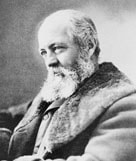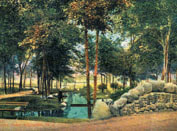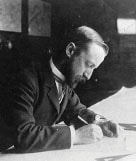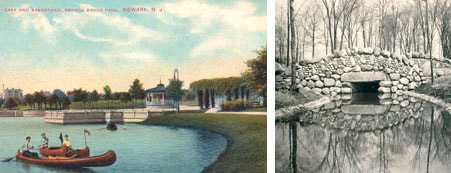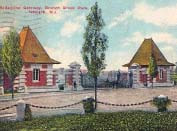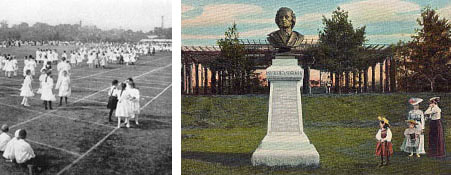Click here to access the Cultural Landscape Report, Volume 2: The History of the Park and Critical Periods of Development.
1862 The land we now know as Branch Brook Park was then the property of the Newark Aqueduct Board. Much of that land was commandeered in July of 1862, at the outbreak of the Civil War; known as Camp Frelinghuysen, it was used as a training ground for New Jersey volunteers. Between 1862 and 1864, six regiments encamped there before fighting in every important battle from Antietam to Appomattox.
1867 The New Jersey State Legislature authorized a Newark Park Commission, with a mandate to locate grounds for a municipal park. Frederick Law Olmsted, the famed landscape architect and designer of Central Park in New York, visited Newark and Essex County and recommended a site encompassing what is now Branch Brook Park. Olmsted and his partner, Calvert Vaux, envisioned Branch Brook Park to be a "grand central park" for the City of Newark. They understood that American cities of the 19th century were growing quickly and changing rapidly. The parks they designed embodied their view that all people, regardless of their position in society, were entitled to fresh air, quiet places and the beauty that only nature can provide.
1889 The Newark Common Council donated 60 acres of the Aqueduct Board property surrounding the circular holding reservoir to "park use." Known as Reservoir Park, the land was left undeveloped. Much of the surrounding neighborhoods were crowded with bleak, unhealthy tenements. To the north lay a dismal marsh known as Old Blue Jay Swamp.
1895 The Essex County Park Commission was formed to enable the creation of a county-wide park system, the first in the nation. The City of Newark transferred Reservoir Park which would become the nucleus of Branch Brook Park to the Commission at a cost of $350,687. The surrounding properties were acquired by the County while donations of land from prominent Newark families extended the park northward. The Ballantine Family donated 32 acres of their property and another 50 acres were given by Z.M. Keene, William A. Righter and the Messrs. Heller. John Bogart and Nathan Barrett were chosen to provide plans and advise on the development of the park. Their design was gardenesque in style, dominated by the geometrically patterned gardens and numerous architectural elements including arbors, viaducts, gazebos and shelters that shaped the park's Southern Division.
1896 Demolition and grading began following Bogart and Barrett's plans.
1898 Dissatisfied with Bogart and Barrett's work, the Commission hired the Olmsted Brothers firm; John Charles Olmsted and Frederick Law Olmsted Jr. were Frederick Law Olmsted Sr.'s nephew/stepson and son. While their work continued that naturalistic style of landscape design championed by their father, in Branch Brook Park they were required to incorporate the elements of Bogart and Barrett's plan that had already been constructed. This led to the Olmsted firm's design concept that consisted of three divisions: the Southern, from Sussex Avenue to Park Avenue, incorporating the elaborate 'gardenesque' elements from Bogart and Barrett; the Middle from Park Avenue to Bloomfield Avenue, which would be a transitional zone, mixing the exotic with the indigenous; and, as the culmination, the Northern Division, the largest and most naturalistic area of the park.
1900 The first Chrysanthemum Show was held in the newly constructed greenhouse in the Northern Division. This annual event brought thousands to the park every fall until 1969.
1903 The United Singing Societies donated the bust of composer Felix Mendelssohn they won in Baltimore, MD, at that year's "Saengerfest," the annual, nationwide German singing competition that generated excitement comparable to today's Super Bowl.
1906 The grand boathouse, designed by the firm of Rossiter and Wright, was added to the southern end of the lake, replacing an earlier structure.
1916 The Essex County Park System built its Administration Building on the parkland that had been set aside to provide a view from Councourse Hill. Designed by New Jersey native Harold Van Buren Magonigle, the exterior has eight different shades of coarse-textured terra brick and expensive terra cotta reliefs especially notable around the main entrance. Under the wide overhang of the tile roof are colorful, allegorical decorations executed by Mrs. Edith Magonigle.
1924 Industrialist and philanthropist Harmon W. Hendricks, owner of a copper rolling mill on the Second River, donated his family home and the adjoining 23 acres to the north of Branch Brook Park. An additional 94 acres were acquired by the county to link Hendricks Field Golf Course and Bellville Park in an unbroken swath of green. This land included what was the first landing site for the U.S. Postal Service where bi-winged airplanes landed on a short field with bales of hay rimming the end of the runway to prevent accidents.
1927 Caroline Bamberger Fuld donates 2,000 Japanese flowering cherry trees to a display in Newark that would rival that in Washington, D.C. The Olmsted Brothers' firm laid out the trees naturalistically on the tiered slopes along the narrow valley of the Second River, evoking the way the trees would be seen in Japan and distinguishing Branch Brook Park's display from all others. Eventually the collection would grow to more than 3,000 trees.
1862 The land we now know as Branch Brook Park was then the property of the Newark Aqueduct Board. Much of that land was commandeered in July of 1862, at the outbreak of the Civil War; known as Camp Frelinghuysen, it was used as a training ground for New Jersey volunteers. Between 1862 and 1864, six regiments encamped there before fighting in every important battle from Antietam to Appomattox.
1867 The New Jersey State Legislature authorized a Newark Park Commission, with a mandate to locate grounds for a municipal park. Frederick Law Olmsted, the famed landscape architect and designer of Central Park in New York, visited Newark and Essex County and recommended a site encompassing what is now Branch Brook Park. Olmsted and his partner, Calvert Vaux, envisioned Branch Brook Park to be a "grand central park" for the City of Newark. They understood that American cities of the 19th century were growing quickly and changing rapidly. The parks they designed embodied their view that all people, regardless of their position in society, were entitled to fresh air, quiet places and the beauty that only nature can provide.
1889 The Newark Common Council donated 60 acres of the Aqueduct Board property surrounding the circular holding reservoir to "park use." Known as Reservoir Park, the land was left undeveloped. Much of the surrounding neighborhoods were crowded with bleak, unhealthy tenements. To the north lay a dismal marsh known as Old Blue Jay Swamp.
1895 The Essex County Park Commission was formed to enable the creation of a county-wide park system, the first in the nation. The City of Newark transferred Reservoir Park which would become the nucleus of Branch Brook Park to the Commission at a cost of $350,687. The surrounding properties were acquired by the County while donations of land from prominent Newark families extended the park northward. The Ballantine Family donated 32 acres of their property and another 50 acres were given by Z.M. Keene, William A. Righter and the Messrs. Heller. John Bogart and Nathan Barrett were chosen to provide plans and advise on the development of the park. Their design was gardenesque in style, dominated by the geometrically patterned gardens and numerous architectural elements including arbors, viaducts, gazebos and shelters that shaped the park's Southern Division.
1896 Demolition and grading began following Bogart and Barrett's plans.
1898 Dissatisfied with Bogart and Barrett's work, the Commission hired the Olmsted Brothers firm; John Charles Olmsted and Frederick Law Olmsted Jr. were Frederick Law Olmsted Sr.'s nephew/stepson and son. While their work continued that naturalistic style of landscape design championed by their father, in Branch Brook Park they were required to incorporate the elements of Bogart and Barrett's plan that had already been constructed. This led to the Olmsted firm's design concept that consisted of three divisions: the Southern, from Sussex Avenue to Park Avenue, incorporating the elaborate 'gardenesque' elements from Bogart and Barrett; the Middle from Park Avenue to Bloomfield Avenue, which would be a transitional zone, mixing the exotic with the indigenous; and, as the culmination, the Northern Division, the largest and most naturalistic area of the park.
1900 The first Chrysanthemum Show was held in the newly constructed greenhouse in the Northern Division. This annual event brought thousands to the park every fall until 1969.
1903 The United Singing Societies donated the bust of composer Felix Mendelssohn they won in Baltimore, MD, at that year's "Saengerfest," the annual, nationwide German singing competition that generated excitement comparable to today's Super Bowl.
1906 The grand boathouse, designed by the firm of Rossiter and Wright, was added to the southern end of the lake, replacing an earlier structure.
1916 The Essex County Park System built its Administration Building on the parkland that had been set aside to provide a view from Councourse Hill. Designed by New Jersey native Harold Van Buren Magonigle, the exterior has eight different shades of coarse-textured terra brick and expensive terra cotta reliefs especially notable around the main entrance. Under the wide overhang of the tile roof are colorful, allegorical decorations executed by Mrs. Edith Magonigle.
1924 Industrialist and philanthropist Harmon W. Hendricks, owner of a copper rolling mill on the Second River, donated his family home and the adjoining 23 acres to the north of Branch Brook Park. An additional 94 acres were acquired by the county to link Hendricks Field Golf Course and Bellville Park in an unbroken swath of green. This land included what was the first landing site for the U.S. Postal Service where bi-winged airplanes landed on a short field with bales of hay rimming the end of the runway to prevent accidents.
1927 Caroline Bamberger Fuld donates 2,000 Japanese flowering cherry trees to a display in Newark that would rival that in Washington, D.C. The Olmsted Brothers' firm laid out the trees naturalistically on the tiered slopes along the narrow valley of the Second River, evoking the way the trees would be seen in Japan and distinguishing Branch Brook Park's display from all others. Eventually the collection would grow to more than 3,000 trees.
1928 The Morris Canal that ran from Jersey City to the Delaware River and formed the park's western boundary was abandoned and became the Newark City Subway. Now Newark Light Rail, there are six stops along the park that provide easy access by mass transit.
1940 The Rossiter and Wright boathouse was deemed unsafe and dismantled. A smaller building replaced the grand structure
1940 The Rossiter and Wright boathouse was deemed unsafe and dismantled. A smaller building replaced the grand structure
1956 More than 3,000 people attended the Fall Chrysanthemum Show in the greenhouses.
1967 Riots broke out in Newark and devastated the community. Many buildings were burned, boarded up and sections of the city were deserted. The National Guard was called in to maintain order and bivouacs in Branch Brook Park where Civil War volunteers mustered 100 years earlier.
1974 Community members rallied to save their beloved park and the Friends of Branch Brook Park was formed.
1976 The Newark Cherry Blossom Festival was established.
1980 Branch Brook Park was placed on the New Jersey Register of Historic Places (view here).
1981 The Park was placed on the National Register of Historic Places.
1986 The Boathouse was destroyed by fire and replaced by a concrete block structure.
1967 Riots broke out in Newark and devastated the community. Many buildings were burned, boarded up and sections of the city were deserted. The National Guard was called in to maintain order and bivouacs in Branch Brook Park where Civil War volunteers mustered 100 years earlier.
1974 Community members rallied to save their beloved park and the Friends of Branch Brook Park was formed.
1976 The Newark Cherry Blossom Festival was established.
1980 Branch Brook Park was placed on the New Jersey Register of Historic Places (view here).
1981 The Park was placed on the National Register of Historic Places.
1986 The Boathouse was destroyed by fire and replaced by a concrete block structure.
1999 Branch Brook Park Alliance (BBPA) was formed.
2002 BBPA hired Rhodeside & Harwell (RHI), nationally recognized landscape architects, to produce a Cultural Landscape Report, Treatment and Management Plan, to serve as a blueprint for the park's restoration.
2003 The lake edge near the boat house in the Southern District was replanted to recreate the original Olmsted plan; this pilot project was designed by RHI and funded by BBPA.
2004 A tree inventory was conducted by BBPA as part of the Cultural Landscape Report and revealed that less than 1,000 cherry trees remained from the original gift of 2,000 trees and subsequent plantings.
2005 Responding to community interest, the first farmers' market took place, along with other activities to help reactivate the park.
2006 BBPA, together with the Essex County, the North Ward Center and the Newark Boys and Girls Clubs developed the Middle Division ball fields, now home to 7,500 ballplayers annually.
A grant from the Essex County Recreation and Open Space Trust Fund enabled the first planting of what would total more than 3,000 new cherry trees over the next four years.
2007 The Ballfields in the Extension were redesigned and upgraded while the surrounding landscape is restored. The Cherry Tree Demonstration Project showed what a fully restored collection should look like with extensive companion plantings and appropriate hardscaping.
2008 The Octagon Shelter was reconstructed. The Waterway Rehabilitation Feasibility Study was completed, setting forth a path for the restoration of one of the park's most salient features.
2009 Prudential Global Volunteer Day drew more than 300 participants from diverse sectors of the community.
2010 Design work was completed for projects that will transform western lake edge in the Southern Division. The rehabilitation of the Octagon Field House in the Middle Division was completed.
2014 Essex County Executive Joseph N. DiVincenzo, Jr. and the Branch Brook Park Alliance announced the opening of the Children's Garden in Essex County Branch Brook Park in Newark on Tuesday, August 12.
2017 We began a three year pilot phase with Jersey Cares to launch Care of the Park, a legacy initiative of Branch Brook Park Alliance and the conservancy for Essex County Branch Brook Park.
Branch Brook Park Alliance launched Park Ambassadors, a summer youth employment and workforce developmet program in partnership with the City of Newark.
2019 A bust of Frederick Law Olmsted, Sr. was installed in the formal gardens of the southern division.
2020 After a successful three-year pilot phase we began full implementation in care of the park under the leadership of a President & CEO.
2002 BBPA hired Rhodeside & Harwell (RHI), nationally recognized landscape architects, to produce a Cultural Landscape Report, Treatment and Management Plan, to serve as a blueprint for the park's restoration.
2003 The lake edge near the boat house in the Southern District was replanted to recreate the original Olmsted plan; this pilot project was designed by RHI and funded by BBPA.
2004 A tree inventory was conducted by BBPA as part of the Cultural Landscape Report and revealed that less than 1,000 cherry trees remained from the original gift of 2,000 trees and subsequent plantings.
2005 Responding to community interest, the first farmers' market took place, along with other activities to help reactivate the park.
2006 BBPA, together with the Essex County, the North Ward Center and the Newark Boys and Girls Clubs developed the Middle Division ball fields, now home to 7,500 ballplayers annually.
A grant from the Essex County Recreation and Open Space Trust Fund enabled the first planting of what would total more than 3,000 new cherry trees over the next four years.
2007 The Ballfields in the Extension were redesigned and upgraded while the surrounding landscape is restored. The Cherry Tree Demonstration Project showed what a fully restored collection should look like with extensive companion plantings and appropriate hardscaping.
2008 The Octagon Shelter was reconstructed. The Waterway Rehabilitation Feasibility Study was completed, setting forth a path for the restoration of one of the park's most salient features.
2009 Prudential Global Volunteer Day drew more than 300 participants from diverse sectors of the community.
2010 Design work was completed for projects that will transform western lake edge in the Southern Division. The rehabilitation of the Octagon Field House in the Middle Division was completed.
2014 Essex County Executive Joseph N. DiVincenzo, Jr. and the Branch Brook Park Alliance announced the opening of the Children's Garden in Essex County Branch Brook Park in Newark on Tuesday, August 12.
2017 We began a three year pilot phase with Jersey Cares to launch Care of the Park, a legacy initiative of Branch Brook Park Alliance and the conservancy for Essex County Branch Brook Park.
Branch Brook Park Alliance launched Park Ambassadors, a summer youth employment and workforce developmet program in partnership with the City of Newark.
2019 A bust of Frederick Law Olmsted, Sr. was installed in the formal gardens of the southern division.
2020 After a successful three-year pilot phase we began full implementation in care of the park under the leadership of a President & CEO.

